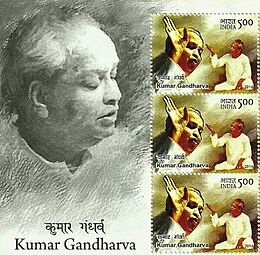Kumar Gandharva facts for kids
Pandit Kumar Gandharva (born Shivaputra Siddharamayya Komkalimath; 8 April 1924 – 12 January 1992) was a famous classical singer from India. He was known for his special singing style. He didn't follow the rules of any specific gharana (a traditional school of music). The name Kumar Gandharva was given to him when he was a child. It means "musical spirit," like a talented musician from Hindu stories.
Contents
Early Life and Learning Music
Kumar Gandharva was born in a place called Sulebhavi in Karnataka, India. He showed amazing musical talent from a very young age. By the time he was five, everyone could see he was a musical genius. He performed on stage for the first time when he was just 10 years old.
When he was 11, his father sent him to learn music from a famous teacher, B.R. Deodhar. Kumar Gandharva learned very quickly. He understood music so well that he was teaching at the same school before he turned 20. By his early twenties, he was already a big star in the music world.
His Music Journey
In the late 1940s, Kumar Gandharva became very sick with tuberculosis. Doctors thought he might never sing again. They told him to move to Dewas, a city with a drier climate, to help him get better.
For six years, he was very ill and couldn't sing. Doctors warned him that singing could be dangerous. During this time, he would lie in bed and listen to nature's sounds. He listened to birds, the wind, and even street singers passing by. He would hum softly to himself. This quiet time helped him think about new ways to sing. He started to think about Nirguni bhajans, which are devotional songs about a formless god.
In 1952, a new medicine for tuberculosis, called streptomycin, became available. Kumar Gandharva started taking it. Slowly, with great medical care and help from his wife, Bhanumati, he got better. He began to sing again. However, his illness changed his voice forever. One of his lungs was damaged, so he had to learn to sing using only one lung.
His first concert after getting well was in 1953. The illness made his singing unique. He became known for singing powerful, short musical phrases. He also had a very high voice.
New Ways of Singing
Kumar Gandharva loved to try new things with music. He sang Nirguni bhajans (devotional songs) and folk songs. He also experimented with different ragas (melodies) and how he performed them. He often changed from fast to slow parts within the same raga.
He is remembered for being very creative. He questioned old traditions but didn't completely reject them. This made his music feel connected to the roots of Indian culture, especially the folk music of Madhya Pradesh. He even created new ragas by mixing parts of older ones.
Family and Students
Vasundhara Komkali, Kumar Gandharva's second wife, was also his student. They often sang bhajans (devotional songs) together. Their daughter, Kalapini Komkalimath, later joined them, playing the tanpura.
Kumar Gandharva's musical ideas are still carried on today. His son, Mukul Shivputra, and daughter, Kalapini, are both singers. Many of his students, like Madhup Mudgal and Vijay Sardeshmukh, also continue his style. There is even a foundation, the Kumar Gandharva Foundation, that helps promote Indian classical music. His grandson, Bhuvanesh, is also becoming a well-known classical singer.
Awards and Recognition
Kumar Gandharva was not just a singer; he also thought deeply about music. He had his own ideas about different ragas and singing styles.
He received two of India's highest civilian awards:
- The Padma Bhushan in 1977.
- The Padma Vibhushan in 1990.
Personal Life
Kumar Gandharva married Bhanumati Kans in 1946. She was a student at his teacher's school, and he was her instructor. They fell in love and moved to Dewas in 1947. Soon after, he became very sick, but with new medicines and Bhanumati's care, he recovered.
Their first son, Mukul Shivputra, was born in 1956. Their second son, Yashowardhan, was born in 1961, but sadly, Bhanumati passed away during his birth. After her death, Kumar Gandharva married Vasundhara Shrikhande, who was also a fellow student from his music school. Their daughter, Kalapini Komakalimath, is a well-known singer today.
His Passing
Kumar Gandharva passed away on 12 January 1992, at his home in Dewas. He had suffered from lung problems for many years. His funeral was attended by hundreds of music lovers from all over India.
Legacy
In September 2014, India Post released a special postage stamp featuring Kumar Gandharva. This stamp honored his important contributions to Hindustani music.


